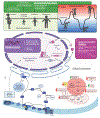Bipolar Disorder
- PMID: 38223491
- PMCID: PMC10786345
- DOI: 10.1016/j.conb.2023.102801
Bipolar Disorder
Abstract
This review focuses on recent advances made towards understanding the neurobiology of bipolar disorder (BD), a chronic neuropsychiatric illness characterized by altered mood and energy states. The past few years have seen the completion of the largest genetic studies by far, which have emphasized the polygenic nature of BD as well as it's connection to other psychiatric illnesses. Furthermore, the use of inducible pluripotent stem cells has rapidly expanded. These studies support previous work that implicates dysregulation of neurodevelopment, mitochondria, and calcium homeostasis, while also allowing for investigation into the underlying mechanisms of individual responsivity to lithium. Sleep and circadian rhythms have also been heavily implicated in BD, from disruptions in activity patterns to molecular abnormalities.
Conflict of interest statement
Declaration of interests The authors declare that they have no known competing financial interests or personal relationships that could have appeared to influence the work reported in this paper.
Figures

References
-
- He H, Hu C, Ren Z, Bai L, Gao F, Lyu J: Trends in the incidence and DALYs of bipolar disorder at global, regional, and national levels: Results from the global burden of Disease Study 2017. Journal of Psychiatric Research 2020, 125:96–105. - PubMed
-
- Hara T, Owada Y, Takata A: Genetics of bipolar disorder: insights into its complex architecture and biology from common and rare variants. J Hum Genet 2023, 68:183–191.* - PubMed
-
• Very thorough review of the history of, and current advances in, research on the genetics of BD.
-
- Mullins N, Forstner AJ, O’Connell KS, Coombes B, Coleman JRI, Qiao Z, Als TD, Bigdeli TB, Børte S, Bryois J, et al.: Genome-wide association study of more than 40,000 bipolar disorder cases provides new insights into the underlying biology. Nat Genet 2021, 53:817–829.** - PMC - PubMed
-
• Largest, most recent genome-wide association study of BD cases.
-
- Hewitt T, Alural B, Tilak M, Wang J, Becke N, Chartley E, Perreault M, Haggarty SJ, Sheridan SD, Perlis RH, et al.: Bipolar disorder-iPSC derived neural progenitor cells exhibit dysregulation of store-operated Ca2+ entry and accelerated differentiation. Mol Psychiatry 2023, doi:10.1038/s41380-023-02152-6. - DOI - PMC - PubMed
-
- Kathuria A, Lopez-Lengowski K, McPhie D, Cohen BM, Karmacharya R: Disease-specific differences in gene expression, mitochondrial function and mitochondria-endoplasmic reticulum interactions in iPSC-derived cerebral organoids and cortical neurons in schizophrenia and bipolar disorder. Discov Ment Health 2023, 3:8. - PMC - PubMed
Publication types
MeSH terms
Substances
Grants and funding
LinkOut - more resources
Full Text Sources
Medical
Miscellaneous

